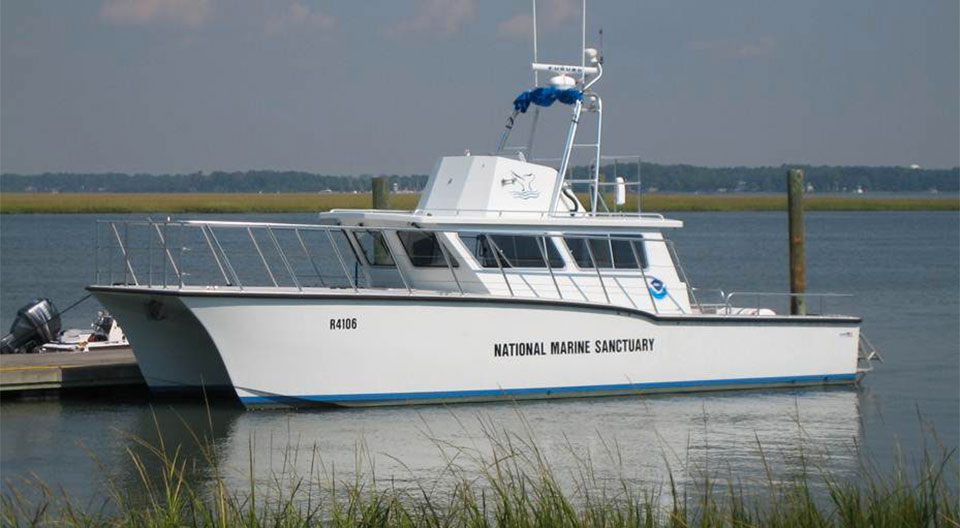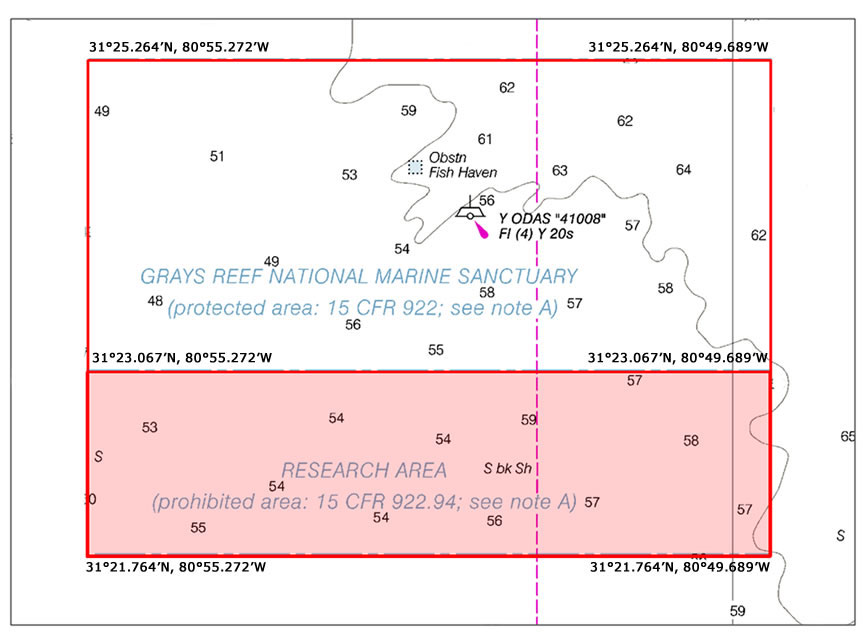Facilitating Science
Gray's Reef

There are several resources available to researchers at Gray’s Reef National Marine Sanctuary. Please contact the Research Coordinator for discussions on facilitating research within the Gray’s Reef National Marine Sanctuary.
Research Coordinator: Kim Roberson
Boats
Gray's Reef NMS operates the R/V Sam Gray and the R/V Joe Ferguson. Both vessels are used for research and monitoring, dive operations, education and outreach, as well as in support of a variety of activities for GRNMS research and academic partners. Trained captain and crew are available for both vessels. Please contact the research coordinator for more information.
Permits
The ONMS has the authority to issue permits to allow some types of activities that are otherwise prohibited by sanctuary regulations, but which generally present a public benefit by furthering the management and protection of sanctuary resources. A permit is not required for all types of research, just those that involve practices that are otherwise prohibited by the sanctuary.
Diving
Gray's Reef is one of the most popular spots off the Georgia coast for recreational diving. The sanctuary is only accessible by private boat. Many independent boat operators run dive trips to the Sanctuary. Gray's Reef does not make recommendations.
Scientific Divers can receive reciprocity to complete work conducted on SCUBA within GRNMS.
Lab Space
Currently, there is no lab space available to researchers at Gray’s Reef National Marine Sanctuary.
Accommodations
Housing is available on Skidaway Island through the Skidaway Institute of Oceanography.
See SKIO for a listing of affordable and comfortable housing options.
Research Areas
Under a new regulation that went into effect December 4th, 2011, the southern third of NOAA's 22-square-mile Gray's Reef National Marine Sanctuary is now a research area where scientists are able to study the impact of human activities on the sanctuary's marine resources. Fishing and diving are prohibited in the research area off the Georgia coast, but vessels are allowed to travel across the area as long as they do not stop and fishing gear is stowed and not available for use.

Data Buoys
The Gray’s Reef Buoy Station is part of a network of buoys providing real-time data on ocean conditions and is maintained by the NOAA National Data Buoy Center. Collected parameters include wind speed and direction, wave height, dominant wave period, average wave period, air temperature, water temperature and atmospheric pressure. A listing of these buoys may be accessed from here.
Equipment and Instruments
- Acoustic Telemetry
- VEMCO receivers and tags
- pCO2 sensor (air/sea interface and at depth)
- pH sensor (air/sea interface and at depth)
- Water Quality sensor: chlorophyll and turbidity (air/sea interface)
- Temperature (at depth)
- Hydrophone (at depth)
- Water Quality sensor at depth (dissolved O2, temperature, conductivity, salinity, pressure, turbidity, chlorophyll)
Key Documents
Gray's Reef Current Scientific Publications (2000-Present)
Grays Reef Historical Scientific Publications (Before 2000)
Gray’s Reef NMS Science Needs
The Science Needs Assessment is designed to provide up to date information on the priority management issues facing national marine sanctuaries and defines the science and information needs necessary to address these issues.
Condition Report
Gray’s Reef Condition Report (2008) and Addendum (2012) summarizes resources in the sanctuary, pressures on those resources, current condition and trends, and management responses to the pressures that threaten the integrity of the marine environment.
Gray’s Reef Management Plan
A Sanctuary management plan is a site-specific planning and management document that describes the objectives, policies, and activities for a sanctuary. The management plan outlines the activities for programs for the Gray’s Reef National Marine Sanctuary (GRNMS) over the next five years and beyond, along with staffing and budget needs, and performance measures.
Monitoring Inventory
National marine sanctuaries conduct and support monitoring programs that target a wide array of topics involving natural processes and human influences on water, habitat, living resources and maritime archaeological resources. The following tables provide a listing of the major subject areas that are being monitored at each sanctuary. For a complete listing and description of all monitoring programs please visit each sanctuary’s Monitoring Inventory.

